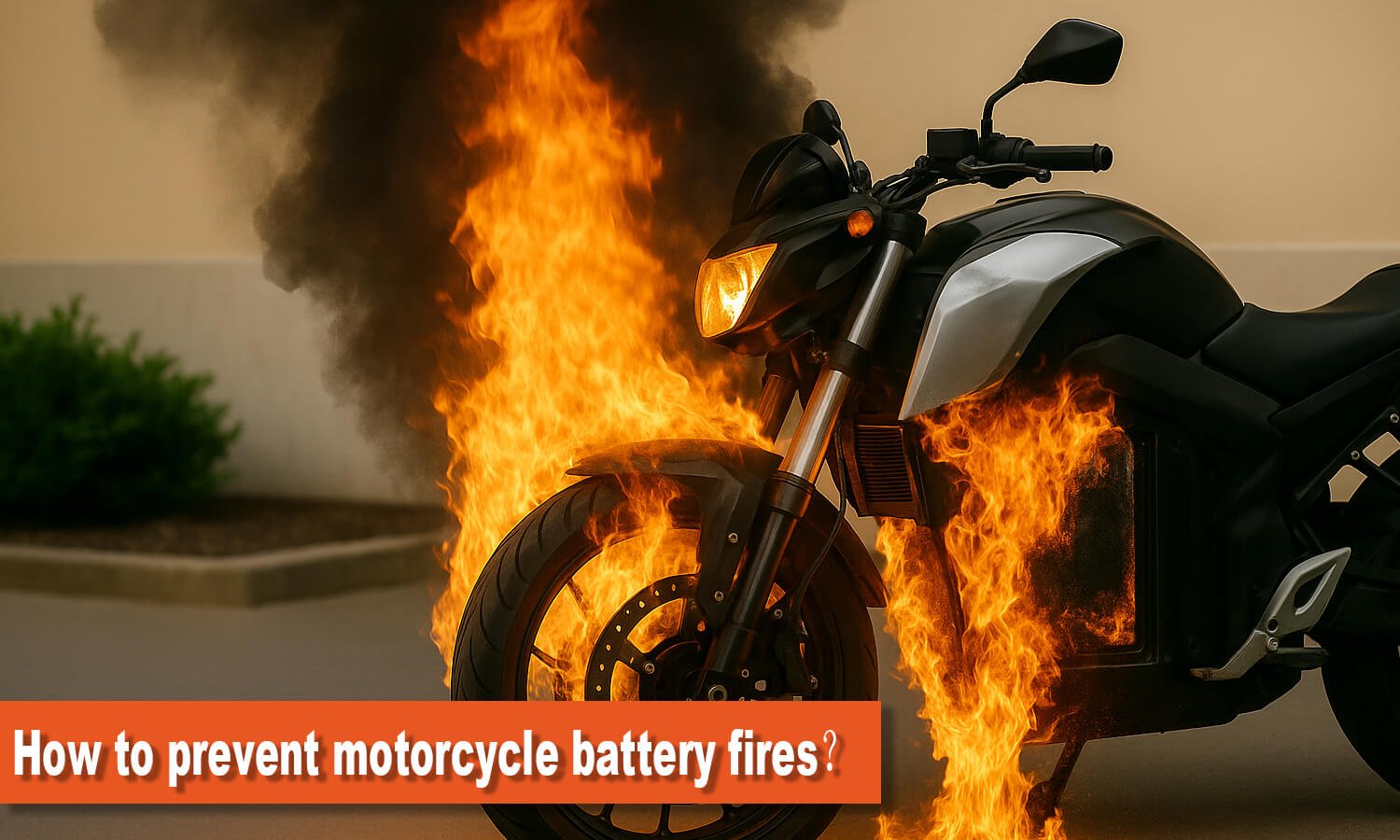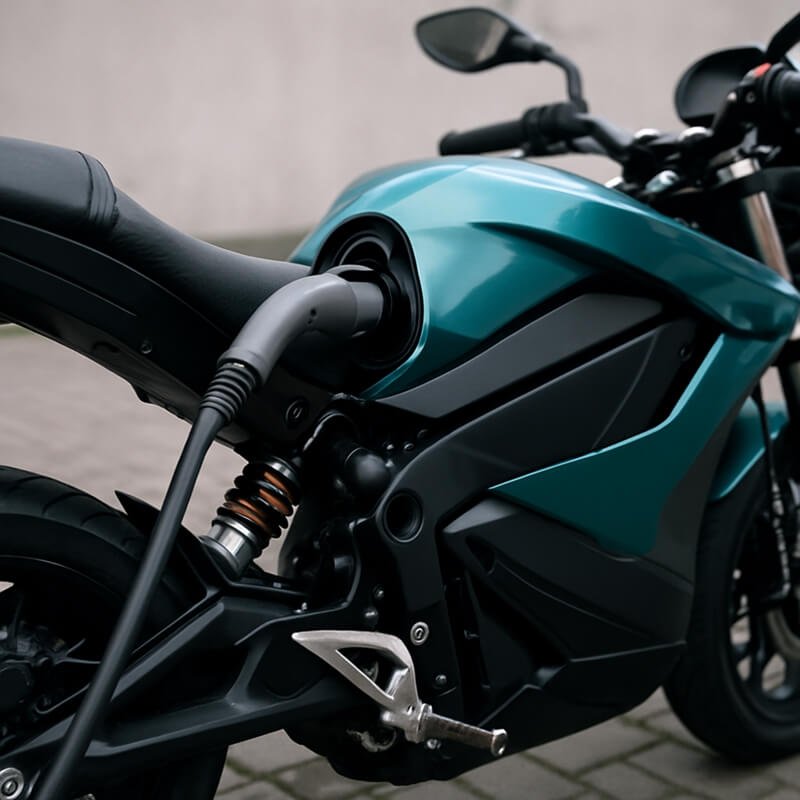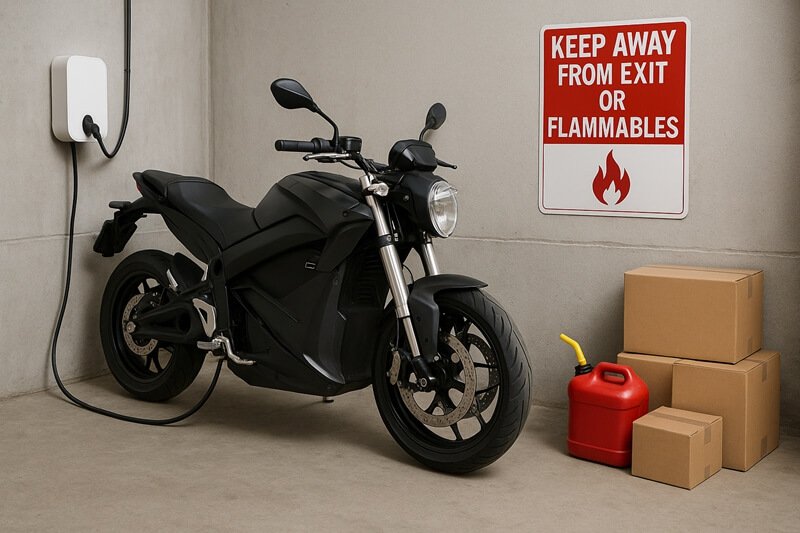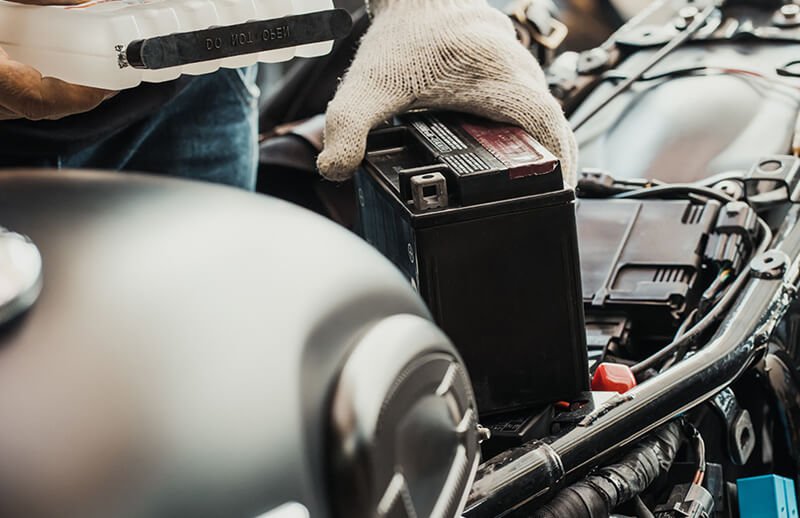Motorcycle riding is all about the sense of freedom, adventure, and thrill of the open road. But come on—being connected when you ride isn't always an easy thing. Whether you're riding with a buddy, navigating traffic in the city, or long-distance riding, effective communication is crucial. That's where the Fodsports T5 and T6 come in, […]

How to prevent motorcycle battery fires?
Lithium-ion batteries power most electric motorcycles, giving riders long range and performance. However, these batteries can overheat or ignite if misused. Preventing motorcycle battery fires starts with understanding the risks and following simple safety steps every time you charge, ride, or store your bike.
This guide summarizes the latest expert advice (2025) on avoiding battery fires in electric motorcycles. It covers safe charging, routine maintenance, storage, warning signs, and the impact of extreme weather. Always prioritize safety by following manufacturer instructions and using common-sense precautions.
Table of Contents
Why Motorcycle Battery Fires Happen

electric motorcycle charging outdoors
Understanding how fires start helps us prevent them. The main causes of lithium-battery fires include:
- Overcharging: Plugging in too long or using the wrong charger can overheat the battery. Overcharging forces the battery to generate excess heat, potentially triggering a fire.
- Physical damage: Dropping the battery or crashing the bike can dent or puncture cells. This can create an internal short circuit, causing the battery to suddenly overheat. Always handle batteries carefully to avoid cracks or dents.
- Manufacturing or design defects: Poorly made batteries or aftermarket packs sometimes lack important safety features. A bad internal design or a missing Battery Management System (BMS) can fail to prevent overcharge/over-discharge, letting a fault lead to fire. Buy batteries from reputable sources and avoid cheap knockoffs.
- Extreme temperatures: Very hot or cold weather stresses lithium cells. In intense heat, the battery’s chemistry can become unstable and cause thermal runaway. In freezing cold, charging can damage cells or the BMS. For example, experts warn that “exposure to extreme temperatures can cause an electric motorcycle battery to catch fire”. Always keep batteries within the manufacturer’s recommended temperature range.
Charging Safely to Prevent Motorcycle Battery Fires
Charging is one of the most critical moments for battery safety. Follow these guidelines every time you plug in your electric motorcycle:
1. Use the proper charger
Always use the charger supplied or approved by the manufacturer of your bike. Chargers and batteries are matched for voltage and current.
Using a random or counterfeit charger can provide the wrong power, overheating the pack.
UL and fire departments stress: only use batteries and chargers that meet recognized safety standards and are specifically designed for your model.
2. Follow charging instructions
Read the owner’s manual and abide by all charging instructions. Set up the charger on a flat, stable surface away from water or spills.
Keep the charging area clear of flammable objects (petroleum, fabrics, paper, etc.).
3. Never leave it unattended
Charging should be watched at all times. Don’t plug in your motorcycle and go to sleep, or leave it charging in another room where you can’t hear or smell problems.
City fire departments repeatedly warn not to leave batteries unattended or charge overnight.
If you notice the bike or battery getting hot while charging, unplug it immediately and move it to a safe place.
4. Keep away from exits and flammables

Keep away from exits and flammables
Position the charging setup so it does not block any exits or hallways. In a fire, you don’t want a charging bike trapping your escape path.
Also, avoid charging next to gas cans, paper boxes, wood, or other combustibles. In parking garages or sheds, put the bike on a non-flammable surface if possible.
5. Avoid power strips or extension cords
Plug the charger directly into a wall outlet. Do not use a power strip or extension cord, as these can overheat under high current.
If the outlet or charger feels warm to touch, unplug it and have an electrician check the circuit.
6. Watch the temperature
Charge the battery only within moderate ambient temperatures. Do not charge in extreme heat or cold.
Safety experts and fire departments caution: “Keep batteries at room temperature when possible. Do not charge them if it’s too cold (below 32°F) or too hot (above 105°F)”.
In practice, avoid charging outside on very hot summer days or during a cold night. Instead, charge in a climate-controlled garage or indoors (with venting) when weather is extreme.
7. Stop at full charge
Once the battery reaches 100%, immediately unplug the charger. Do not fully charge the battery.
Excess charging can cause heat build-up. Modern chargers usually shut off automatically, but it’s safest to still unplug promptly.
Tips to Prevent Motorcycle Battery Fires
Regular maintenance keeps the battery healthy and safe. Incorporate these habits into your routine:
1. Inspect the battery regularly

Inspect the battery regularly
Look over the battery pack and its casing for any signs of damage. Check for cracks, dents, or bulges in the case. Feel for any hotspots or “burning” smells when the battery has been running.
If the bike has been in a crash, assume the battery could be compromised. Seattle fire officials advise to “examine batteries for physical damage like punctures or dents, leaking, swelling, and other signs”.
Never ignore these warning signs. If you spot anything unusual , stop using the bike and get professional help.
2. Keep battery connectors clean
Battery connectors and terminals should be clean and snug. Dust, dirt, or corrosion can interfere with the electrical connection and cause resistance heating.
Wipe the contacts periodically with a dry cloth, and lightly apply the recommended grease or protector if the manual suggests it.
A clean, tight connection ensures efficient power transfer and reduces strain.
3. Avoid completely draining the battery
Try not to ride until the battery is 0%. Deep discharges can stress lithium cells. It’s best to recharge when the battery level drops to around 30–40%.
Likewise, you don’t need to charge to 100% all the time – partial charges are fine for daily use.
In fact, some experts recommend storing batteries at about 50–60% charge if the bike won’t be used for weeks.
This practice extends battery life and reduces fire risk from overcharging or over-discharging.
4. Use only the correct battery pack
If the battery ever needs replacement, be sure to use the pack designed for your motorcycle model.
Don’t try to fit a different size or voltage pack, and avoid “aftermarket” packs that aren’t manufacturer-approved.
CalBike warns that many fires were linked to unapproved batteries without proper cell separation or management.
Aftermarket or cheap replacement batteries may be cheaper, but they often lack safety features.
Stick to genuine or certified batteries recommended by your bike’s maker.
5. Replace old or worn batteries
Lithium batteries slowly degrade over time. If your battery no longer holds charge or shows significant capacity loss, have it checked.
An old battery with internal cell damage is riskier. Likewise, if the BMS (battery management system) signals faults often, service it.
The Occupational Safety and Health Administration advises removing any battery that shows damage, excessive wear, or performance issues.
Never continue to use a suspect battery “just for a short ride” – safety is paramount.
By maintaining the battery and its connections, you prevent many of the issues that can lead to overheating or failure.
Routine care is simple and keeps your battery in good shape, reducing the chance of a fire.
Electric Motorcycle Safe Storage Guidelines
How and where you store your electric motorcycle (and battery) can affect safety:
- Store in a cool, dry place. Heat and humidity accelerate battery degradation and increase fire risk. Keep the bike and its battery out of direct sunlight and away from heat sources (radiators, furnaces, space heaters, etc.). A garage or covered shed is ideal, as long as it stays dry. As OSHA notes, batteries should be kept in “cool and dry environments and away from flammable material”.
- Avoid indoor charging/storage if possible. If you have a dedicated battery room or garage, use it. Storing an electric motorcycle inside living spaces (like a home or apartment) can be hazardous – lithium fires are very hard to extinguish. One expert recommends keeping the bike outside of your home for safety. If you must store indoors temporarily, ensure it is on the ground floor (in case of fire) and not near exits or fabric.
- Keep partial charge for storage. For long-term storage (weeks or months), leave the battery at roughly 50% charge, not fully charged or fully empty. This charge level is generally best for battery health and safety. Check the bike periodically and recharge if the voltage dips too low (avoiding deep discharge).
- Monitor extreme climate changes. In very cold regions, don’t store or charge the battery below freezing. In very hot climates, ensure the storage area is ventilated or air-conditioned. Batteries shouldn’t sit in sweltering heat (e.g., inside a car on a summer day) nor freeze in open air. The Plymouth Fire Department warns not to keep batteries in hot cars or direct sun, as this “is a fire risk”.
- Lock away from tampering. If children or pets are around, keep the bike locked or the battery cover secure. A curious child should not be able to touch the charging port or terminals. Also, store spare batteries separately, in a fireproof container if available, and keep them isolated from flammable materials.
Proper storage means the battery is less likely to face shock or heat that could trigger a problem. Even when not riding, treat your electric motorcycle’s battery with respect and caution.
Recognizing Warning Signs of Battery Problems
Early warning signs let you act before a fire starts. Regularly check your bike and battery for any abnormal symptoms. Stop using the battery if you notice any of the following and seek expert inspection:
- Unusual odor or smoke. A chemical or “plastic” smell coming from the battery area is a bad sign. Smoke or vapor means an internal failure. Never ignore these – remove power immediately.
- Heat or burning. If the battery or bike feels too hot to touch without riding (especially at rest), or if it heats up rapidly while charging, disconnect it. A very hot battery can indicate a short or failing cell.
- Swelling or bulging. Lithium cells will swell when failing. If the battery pack looks puffed up or the casing is warped, stop using it at once. This means internal pressure has risen and the pack is unstable.
- Leaking fluid. Any leakage (liquid or gel) around the battery means damage inside. Clean it up carefully (wear gloves) and get the battery serviced.

Motorcycle battery leaks
- Strange noises. Hissing, popping, or crackling sounds from the battery pack are clear signs of trouble.
- Failure to hold charge. If your battery suddenly can’t charge to full or depletes far quicker than normal, have it checked. A failing cell can cause overheating when trying to maintain voltage.
- Any charger or indicator errors. If the charger’s LEDs blink abnormally or the bike’s dashboard shows battery warnings, investigate. Don’t bypass error codes; they are often telling you something is wrong.
These symptoms are real red flags. Both UL and Seattle safety guides list them clearly: examples include “leaking, swelling, smoking batteries, or hissing/popping sounds”. If any sign appears, stop using the motorcycle immediately, move it outside or to a safe area, and call a professional. It’s better to lose one battery than risk a fire spreading to your home or garage.
Finally, if the bike has been in a crash or extreme event (heavy rain, submersion, etc.), treat the battery with extra caution. Even if it seems okay, have it inspected. Trauma can cause hidden internal damage that later leads to failure.
Climate and Environmental Factors
Weather and environment affect battery safety. Keep these points in mind:
- High ambient temperatures: In hot climates (desert sun, heat waves), lithium batteries can heat up on their own. Park your bike in the shade and avoid charging during the hottest hours. If your area often exceeds 95–100°F (35–40°C), be especially cautious. Heat accelerates degradation and can push a stressed battery into thermal runaway. In summer, minimize direct sun exposure on the bike’s battery.
- Cold weather: Cold reduces a battery’s effective capacity and can make charging difficult or dangerous. Don’t charge below freezing temperatures. For example, experts advise not charging if below 32°F (0°C). If you ride in winter, consider charging indoors or using a temperature-controlled charging station. Also, don’t leave a frozen battery on charge hoping it will warm up; wait until it’s above the safe charging threshold.
- Humidity and water: Battery packs are usually sealed, but heavy rain or flooding could still cause trouble. After riding in the rain or washing the bike, ensure the connectors are dry before plugging in. A wet connection can short. Do not charge a wet battery or inside a flooded area. Keep batteries off the ground in case of minor spills.
- Storms and power surges: During electrical storms, avoid charging or leave the charger unplugged. Lightning strikes and surges can damage batteries. If your area has frequent power outages or surges, use a surge protector or dedicated circuit for the charger.
- Wildfire smoke or emergency situations: If living in a wildfire zone, keep batteries very closely monitored. Smoke and heat from wildfires can raise indoor air temperature; store batteries in the coolest part of your home. In general, keep emergency numbers handy in case you see/hear battery issues.
By accounting for climate, you keep batteries within a safe operating envelope. Extreme weather can be as dangerous as misuse, so be prepared and adapt your practices to local conditions.
Conclusion
Electric motorcycles offer clean, quiet transportation, but their batteries demand respect. By following the tips above, you can greatly reduce the risk of battery fires.
In summary, the key to battery fire prevention is vigilance and care. Think of your motorcycle’s battery as a potential hazard that needs safe handling, just like gasoline in a car. With regular checks and smart habits, you can enjoy your electric motorcycle worry-free and keep both yourself and your property safe.
You may also be interested in:
Top 3 Motorcycle Dangers and Prevention Strategies
Best Motorcycle Battery: Lead-Acid vs AGM vs Gel vs Lithium

Motorcycle mechanic, writer. Interested in motorcycle gear for years. Like to stay up to date with the newest products and techniques of the motorcycle.
If you're looking for a new motorcycle intercom system this year, Fodsports has something exciting in store. The company has launched two new Bluetooth helmet intercoms: T1 and T1 Pro. Both models bring upgraded features, sleek design, and high-definition audio quality for riders who want to stay connected, entertained, and safe on the road. But […]
Fodsports T1 and T1 Pro: The Newest Bluetooth Intercoms for Riders Shop Fodsports T1 Pro Whether you’re cruising on highways, exploring rugged trails, or commuting daily, clear communication is key. Fodsports is thrilled to launch its latest Bluetooth intercoms: the T1 and T1 Pro. Built for riders who demand reliability, versatility, and crystal-clear sound, these […]
Many riders who aren't so tall or ladies just starting to ride bikes need to pick out the best Motorcycles for Short Riders and Women. They gotta look for three key things: a seat that's not too high up, a bike that's not too heavy, and something that looks good enough to give them confidence. […]
Fodsports FX 60C vs FX30C Pro: What's new techs are the FX 60C bringing to us? Fodsports is a brand worth-mention for helmet communication and video recording. This brand has established itself as a key player with its innovative Bluetooth camera intercom systems. Recently, Fodsports has released a new camera intercom, the FX 60C. How […]
The Fodsports FX 60C is leading a revolution in the Bluetooth camera intercoms market. This 2025 newest intercom with camera by Fodsports is designed to enhance your riding experience. This device comes with advanced features like Bluetooth 5.4, 4K HD recording, 10-way intercom, and plenty more. So it is clear that this device seamlessly blends […]

